Posted 4:01 p.m. Monday, April 15, 2013

Mushroom connoisseurs’ mouths should be watering. A UW-L biology professor and his former student have discovered three new species of edible mushrooms in Hixon Forest in La Crosse.
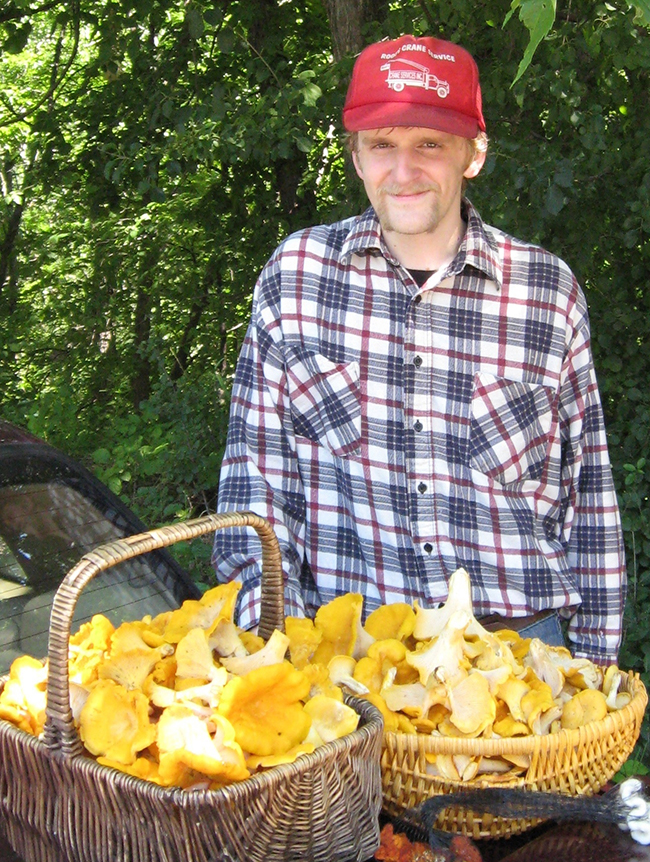 Matthew Foltz, ’11, did research leading to the discovery of three new mushroom species while earning a graduate degree in biology from UW-L. He is currently working in the Herbarium at the University of Michigan.[/caption]
Matthew Foltz, ’11, did research leading to the discovery of three new mushroom species while earning a graduate degree in biology from UW-L. He is currently working in the Herbarium at the University of Michigan.[/caption]
Professors, former student discover three new species of edible mushrooms
Mushroom connoisseurs’ mouths should be watering. A UW-La Crosse biology professor and his former student have discovered three new species of edible mushrooms in Hixon Forest in La Crosse. “A lot of people have been searching the tropical rainforest for new species. While there are a lot of new species there, a lot of new species are here too,” says Biology Professor Tom Volk. Matthew Foltz, a 2011 graduate of UW-L’s Biology Graduate School Program, Volk, and Assistant Biology Professor Kathryn Perez, co-authored a paper documenting the discovery. The news was published in the March-April 2013 edition of Mycologia, one of the top mycology journals in America. The article describes the three new species of mushrooms previously all masquerading under the blanket classification of Chanterelle or Cantharellus cibarius. All three are large, orange-yellow edible mushrooms, which grow in association with hardwood trees, particularly oaks. “I never thought going into this program I would walk away with three new species attached to my name,” admits Foltz, who took his first mycology class from Volk in 2008. “To come this far in that amount of time, I feel like I had a great opportunity. I thank Tom for that opportunity.” Volk says the discovery of a new species within a class of mushrooms folks have foraged for years is symbolic of the little work that has been done in North America to distinguish mushroom species. [caption id="attachment_22408" align="alignright" width="377"]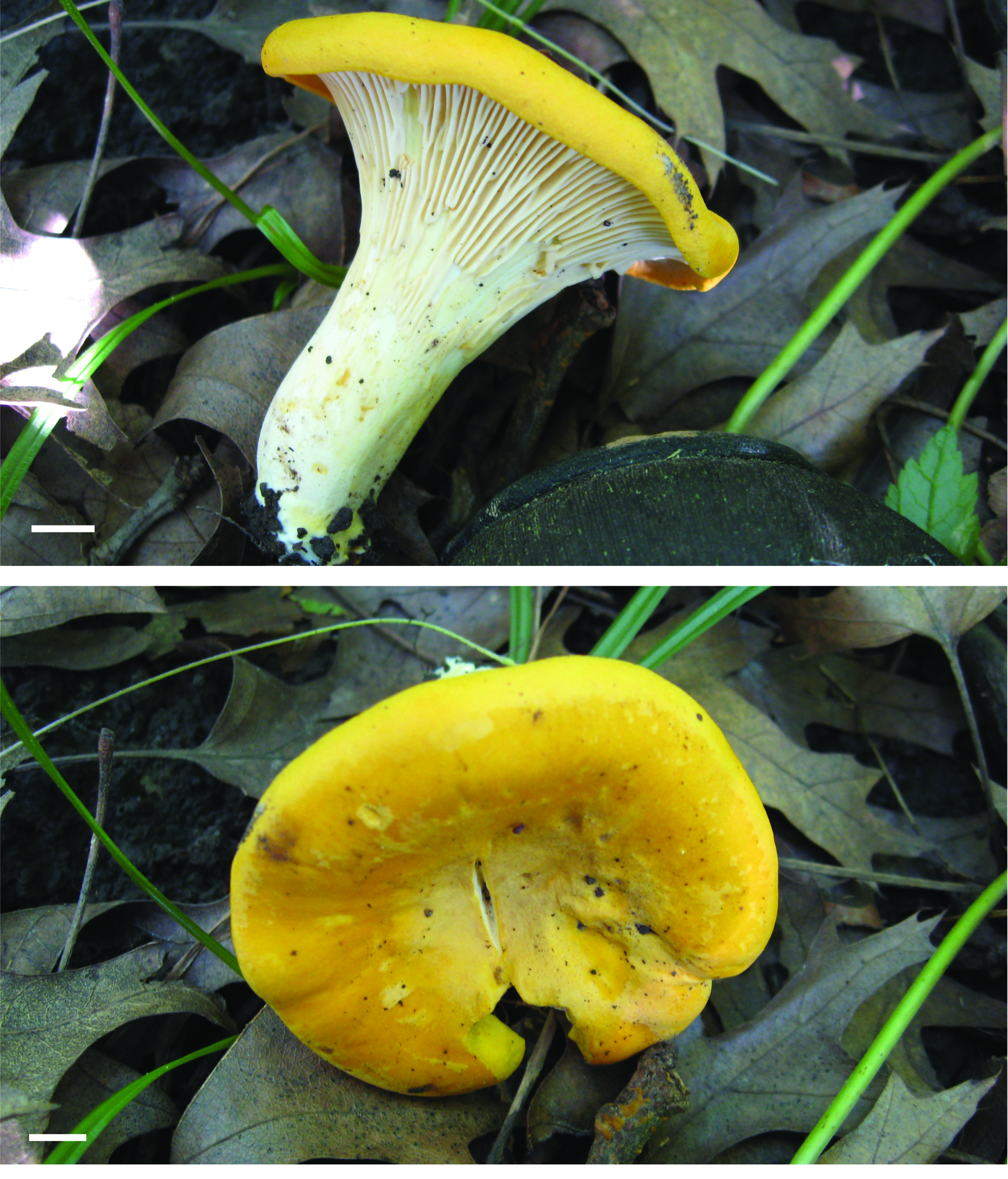 Cantharellus phasmatis (phasmatis means ghostly) is named for its ghostly white colored stem[/caption]
“If new discoveries are being made with these large, conspicuous, edible mushrooms — you can only imagine what is happening with the more obscure species,” explains Volk. “To have these three new species growing within such a small area is pretty remarkable.”
Scientists are uncovering new species of plants and animals at higher rates across North America as methods to extract and sequence DNA have gotten significantly faster and less expensive in the last 20 years, says Perez. Other examples of mushroom species recently differentiated from a parent grouping include honey mushrooms, split into nine species in North America; chicken of the woods or sulfur shelf, five species; and morels, 19 species.
[caption id="attachment_22424" align="alignright" width="372"]
Cantharellus phasmatis (phasmatis means ghostly) is named for its ghostly white colored stem[/caption]
“If new discoveries are being made with these large, conspicuous, edible mushrooms — you can only imagine what is happening with the more obscure species,” explains Volk. “To have these three new species growing within such a small area is pretty remarkable.”
Scientists are uncovering new species of plants and animals at higher rates across North America as methods to extract and sequence DNA have gotten significantly faster and less expensive in the last 20 years, says Perez. Other examples of mushroom species recently differentiated from a parent grouping include honey mushrooms, split into nine species in North America; chicken of the woods or sulfur shelf, five species; and morels, 19 species.
[caption id="attachment_22424" align="alignright" width="372"]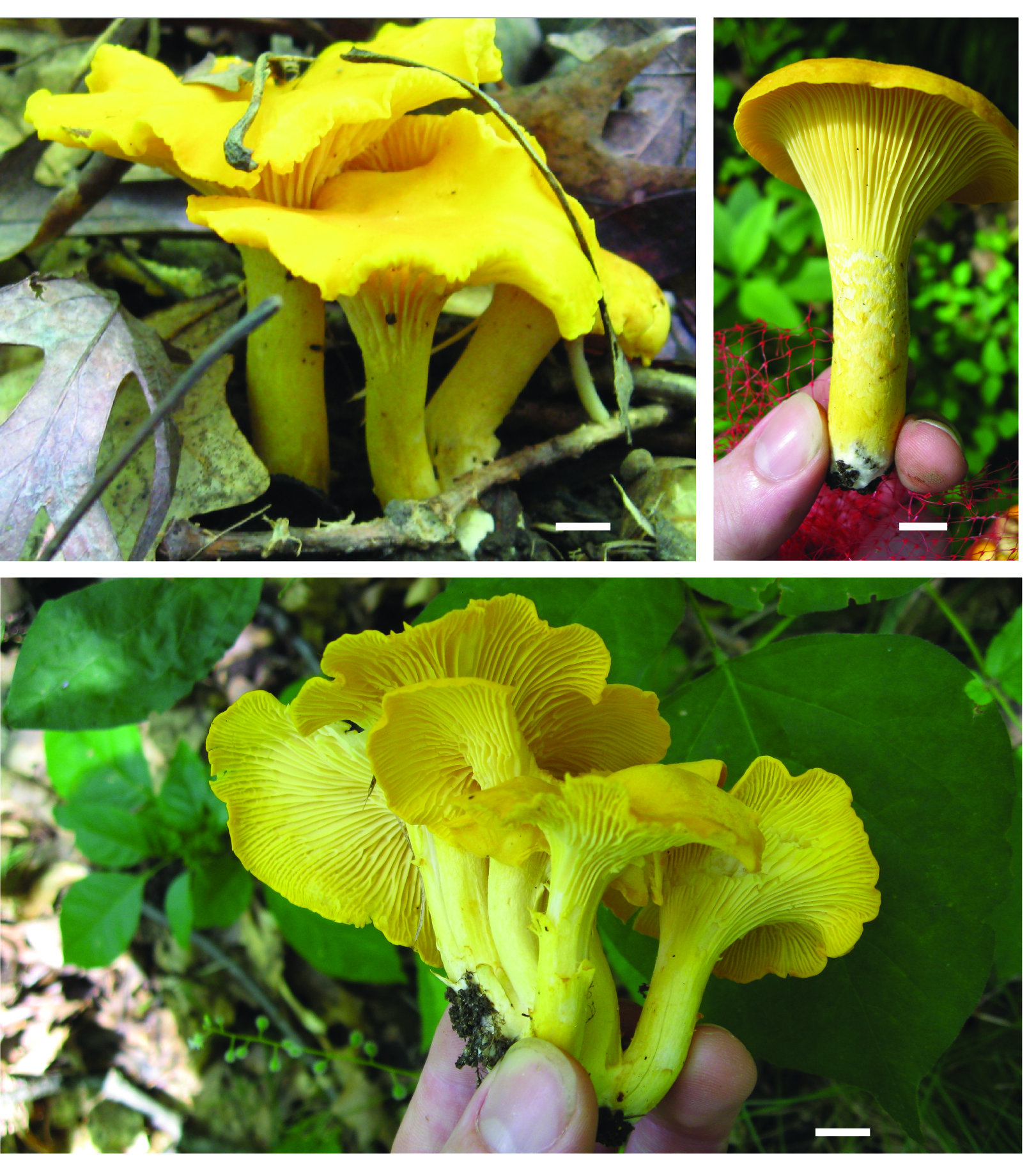 Cantharellus flavus (flavus means yellow) is named for its overall yellow color[/caption]
Volk says this is a sign that many more mushroom discoveries are yet to be made. About 75,000 species of fungi have been described, and experts estimate nearly 1.5 million exist.
Volk and Foltz found the three species within 20 meters of one another in Hixon Forest in La Crosse. They first noticed striking physical differences among the chanterelles — primarily in coloring. Foltz continued to research these apparent differences as his graduate thesis project at UW-L. With help from Perez, Foltz extracted regions of DNA from the mushroom and compared it to closely related chanterelle mushrooms to compare similarities and differences at the molecular level.
“I was training Matt in techniques I use every day in my own work identifying different species of snails,” explains Perez. “I think it is really cool that we’ve found new species in our own backyard where people walk every day.”
[caption id="attachment_22437" align="alignright" width="354"]
Cantharellus flavus (flavus means yellow) is named for its overall yellow color[/caption]
Volk says this is a sign that many more mushroom discoveries are yet to be made. About 75,000 species of fungi have been described, and experts estimate nearly 1.5 million exist.
Volk and Foltz found the three species within 20 meters of one another in Hixon Forest in La Crosse. They first noticed striking physical differences among the chanterelles — primarily in coloring. Foltz continued to research these apparent differences as his graduate thesis project at UW-L. With help from Perez, Foltz extracted regions of DNA from the mushroom and compared it to closely related chanterelle mushrooms to compare similarities and differences at the molecular level.
“I was training Matt in techniques I use every day in my own work identifying different species of snails,” explains Perez. “I think it is really cool that we’ve found new species in our own backyard where people walk every day.”
[caption id="attachment_22437" align="alignright" width="354"]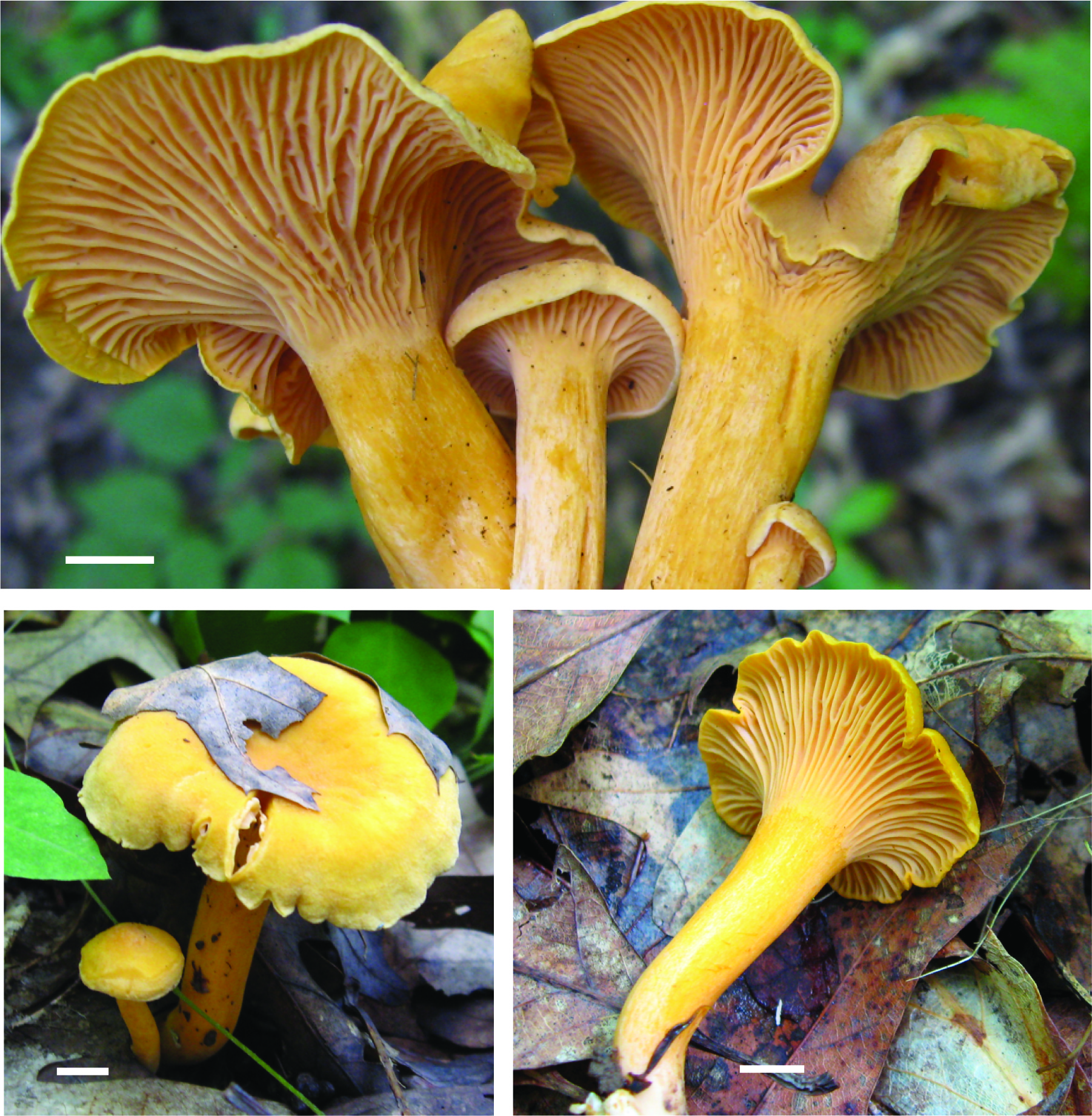 Cantharellus spectaculus (spectaculus means spectacular) is simply spectacular because the contrast of its orange and salmon/purple coloring[/caption]
The DNA sequencing and analysis gave the researchers the confidence to split the color variants into different species, Volk explained. Volk and Foltz named the new species based on their appearance. Cantharellus phasmatis (phasmatis means ghostly) is named for its ghostly white colored stem. Cantharellus flavus (flavus means yellow) is named for its overall yellow color. Cantharellus spectaculus (spectaculus means spectacular) is simply spectacular because the contrast of its orange and salmon/purple coloring,” says Volk.
Documenting the new species, their locations, and physical differences including taste, will be of interest to the culinary industry, says Volk. It also has benefits for the scientific community because documenting biodiversity is a critical part of ecology and the long-term sustainability of a species. Like any good study, it also generates more questions such as where else in North America or the world these species will be identified, notes Volk. This study was an offshoot of another study that collected and documented mushrooms and other fungi from Hixon Forest, where more than 450 species have been documented so far.
[caption id="attachment_22457" align="alignright" width="365"]
Cantharellus spectaculus (spectaculus means spectacular) is simply spectacular because the contrast of its orange and salmon/purple coloring[/caption]
The DNA sequencing and analysis gave the researchers the confidence to split the color variants into different species, Volk explained. Volk and Foltz named the new species based on their appearance. Cantharellus phasmatis (phasmatis means ghostly) is named for its ghostly white colored stem. Cantharellus flavus (flavus means yellow) is named for its overall yellow color. Cantharellus spectaculus (spectaculus means spectacular) is simply spectacular because the contrast of its orange and salmon/purple coloring,” says Volk.
Documenting the new species, their locations, and physical differences including taste, will be of interest to the culinary industry, says Volk. It also has benefits for the scientific community because documenting biodiversity is a critical part of ecology and the long-term sustainability of a species. Like any good study, it also generates more questions such as where else in North America or the world these species will be identified, notes Volk. This study was an offshoot of another study that collected and documented mushrooms and other fungi from Hixon Forest, where more than 450 species have been documented so far.
[caption id="attachment_22457" align="alignright" width="365"]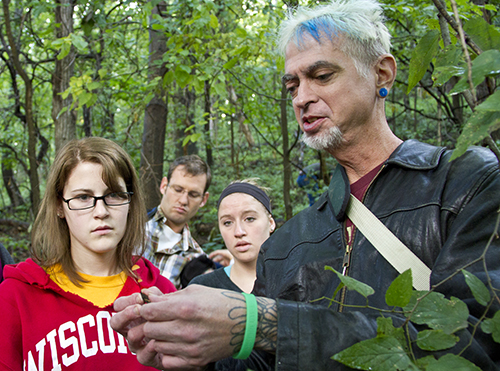 Biology Professor Tom Volk teaches a mycology class in Hixon Forest.[/caption]
Cantharellus phasmatis and Cantharellus flavus are documented so far throughout the Midwest and into the northeastern United States. Cantharellus spectaculus has only been identified in La Crosse thus far. The three species appear primarily in July and August in Wisconsin.
Volk has discovered two other species of mushroom, Armillaria nabsnona or honey mushroom No. 9 and one of the morel species, Morchella importuna,. He has renamed many others.
Check out the article in Mycological Society of America's peer-reviewed journal, Mycologia.
>Learn more about the discovery.
Learn more about professor Tom Volk and his studies via his fungus website.
Biology Professor Tom Volk teaches a mycology class in Hixon Forest.[/caption]
Cantharellus phasmatis and Cantharellus flavus are documented so far throughout the Midwest and into the northeastern United States. Cantharellus spectaculus has only been identified in La Crosse thus far. The three species appear primarily in July and August in Wisconsin.
Volk has discovered two other species of mushroom, Armillaria nabsnona or honey mushroom No. 9 and one of the morel species, Morchella importuna,. He has renamed many others.
Check out the article in Mycological Society of America's peer-reviewed journal, Mycologia.
>Learn more about the discovery.
Learn more about professor Tom Volk and his studies via his fungus website.